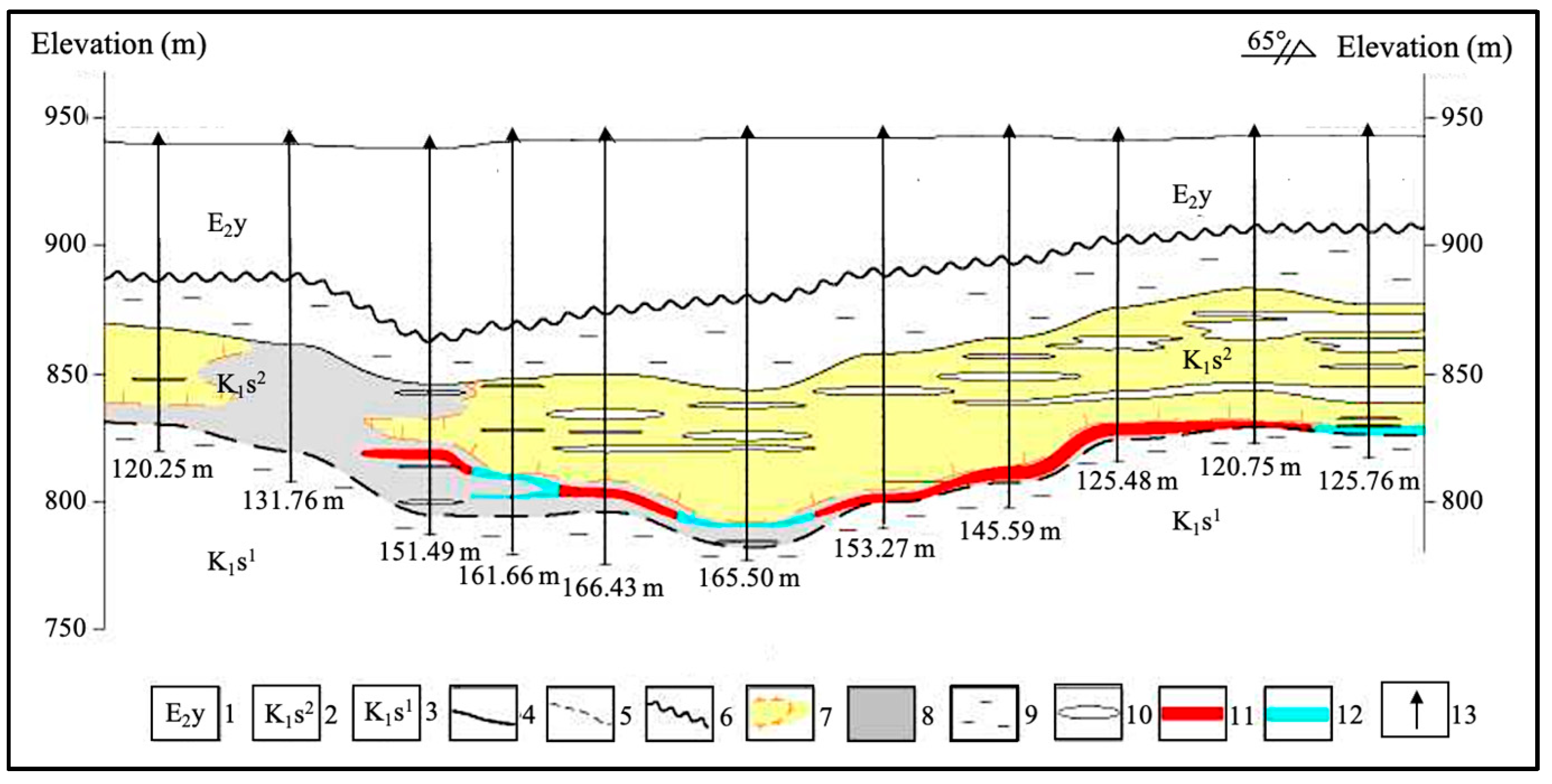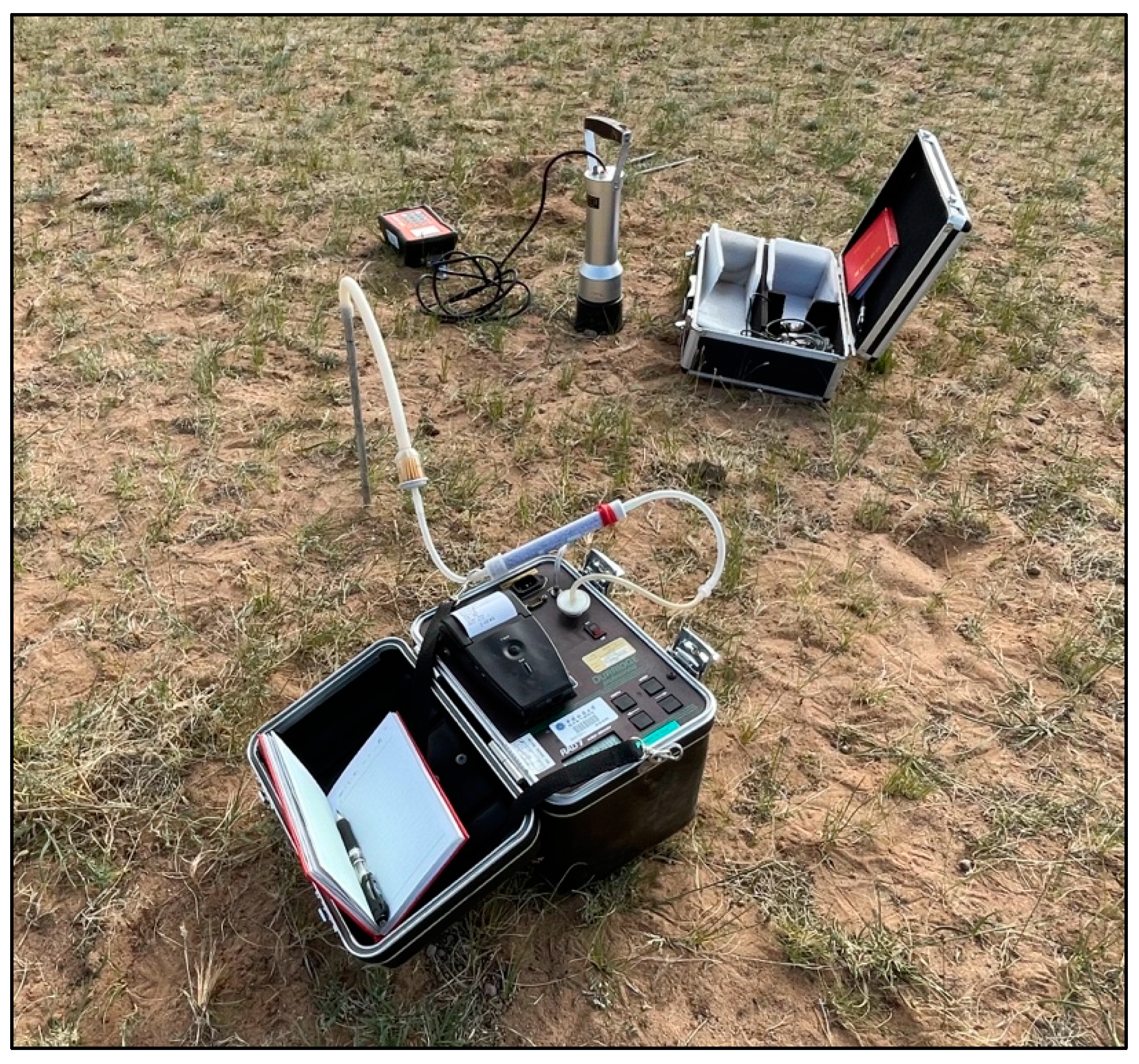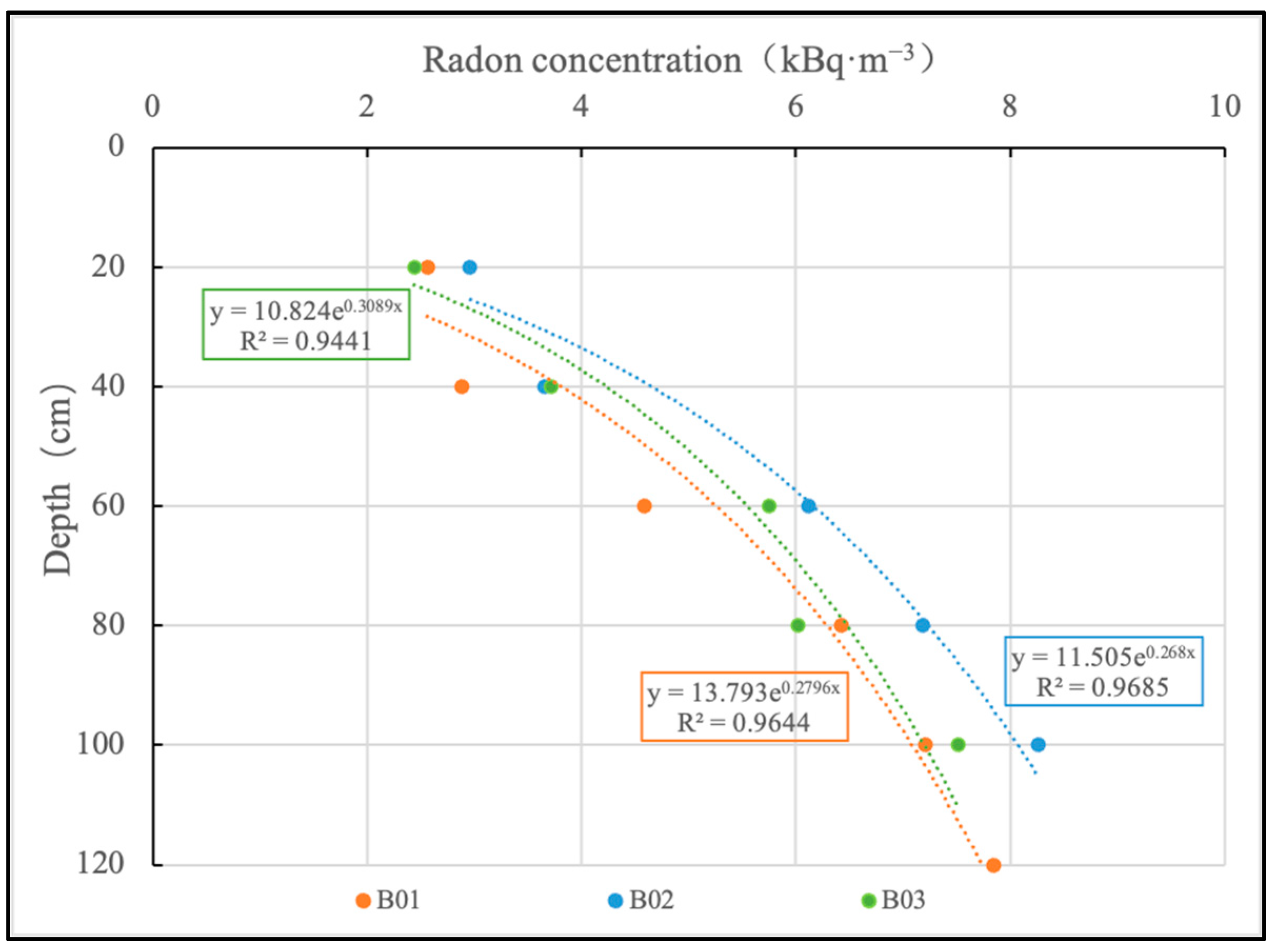Distribution of Radionuclides in the Surface Covering of the Barun Uranium Mining Area in Erlian Basin, Inner Mongolia
Abstract
1. Introduction
2. Materials and Methods
2.1. Study Area
2.2. Field Measurements
2.3. Calculation of Soil Properties
2.4. Soil Radon Diffusion Coefficient and Calculated Radon Concentration
3. Results
3.1. Characteristics of the Planar Distribution of Soil Radon Concentrations
3.2. Characteristics of the Planar Distribution of Soil Uranium, Thorium, and Potassium Contents
3.3. Profile Distribution Characteristics of Soil Radionuclide Content and Soil Properties and Their Correlation
4. Discussion
5. Conclusions
- Along the tendency direction of the orebody, the soil radon concentration showed a “double peak” characteristic, with the ground projection area of the orebody showing a relatively low value. Relatively high values were present on the north and south sides of the orebody. The uranium content in the soil showed the background value in the ground projection area of the orebody, and there were local relatively high values on the north side of the orebody and near the southern boundary of the orebody.
- The low value of soil radon concentration in the ground projection area of the orebody was related to the fact that the soil was mainly sand body with high permeability, and that the uranium content in the soil was relatively low. The soil radon concentration and soil uranium content showed a positive correlation. The abnormally high radon concentration on the north and south sides of the orebody was not only affected by soil uranium content and soil properties. The anomalously high radon concentration occurred within about 2 km north of the northern boundary of the orebody and within about 1.3 km south of the southern boundary of the orebody.
- The relative change in uranium in the soil in the study area was related to the activation and re-enrichment of uranium in the soil. Relatively high uranium values were distributed within about 1.5 km north of the northern boundary of the orebody and near the southern boundary of the orebody.
Supplementary Materials
Author Contributions
Funding
Data Availability Statement
Acknowledgments
Conflicts of Interest
References
- Wu, H.S.; Lin, Y.F.; Bai, Y.S. Radon Measuring Method and Application; Atomic Energy Press: Beijing, China, 1995. [Google Scholar]
- Liu, W.S.; Li, B.H.; Shi, Q.P.; Jia, L.C.; Zhao, X.Q. Model and application of radon anomaly in soil of sandstone type uranium deposits in Erlian Basin. Geophys. Geochem. Explor. 2015, 39, 234–239. (In Chinese) [Google Scholar] [CrossRef]
- Shi, L.C.; Zhang, X.; Yang, Y.Q.; Han, P.H.; Niu, J.J.; Lv, Y.Y.; Zhou, Z.J.; Shen, Z.X. Comprehensive geophysical and geochemical characteristics of the Hadatu uranium deposit in Erlian Basin and their prospecting significance. Geol. Explor. 2022, 58, 0274–0285. (In Chinese) [Google Scholar] [CrossRef]
- Wu, Q.B.; Chen, C.; Yang, L.Q.; Yu, X.; Gao, L.J.; Zhou, J.J.; Liu, W.S. Study of integrated geophysical characteristics of paleo-valley sandstone-type uranium deposits in the middle of the Erenhot basin. Acta Geol. Sin. 2021, 95, 2521–2536. (In Chinese) [Google Scholar] [CrossRef]
- Tan, C.L.; Xie, H.N.; Tang, S.X. The experiment of seven radioactive methods in the exploration of sandstone-type uranium deposits. World Nucl. Geosci. 2007, 3, 172–177. (In Chinese) [Google Scholar]
- Zhang, L.; Guo, L.; Liu, L.L.; Yuan, L.; Li, Y.F.; Bai, S.H. The application of activated carbon radon measurement method for sandstone-type uranium exploration in Shuanglong area, southern Ordos basin. World Nucl. Geosci. 2018, 3, 154–160. (In Chinese) [Google Scholar] [CrossRef]
- Shen, Z.X. The Application of Radon Survey by Activated Carbon in the Exploration of Sandstone-type Uranium Deposit in Teguidda, Niger. Uranium Geol. 2012, 4, 250–256. (In Chinese) [Google Scholar] [CrossRef]
- Card, J.W.; Bell, K. Collection of radon decays products—A uranium exploration technique. J. Geochem. Explor. 1982, 17, 63–76. [Google Scholar] [CrossRef]
- Gingrich, J.E.; Fisher, J.C. Uranium exploration using the Track Etch method. In Proceedings of the Exploration of Uranium Ore Deposits, Vienna, Austria, 29 March–2 April 1976. [Google Scholar]
- Khan, H.A.; Akber, R.A.; Ahmad, I. The use of Alpha Sensitive Plastic Films (ASPF) for uranium/thorium exploration and prospecting. Radiat. Phys. Chem. 1978, 11, 295–297. [Google Scholar] [CrossRef]
- Pedersen, C.P.; Donbier, J.; Gingrich, J.E. Experience with the Track Etch Method for Uranium Exploration in Northern Australia. In Uranium in the Pine Creek Geosyncline; Ferguson, J., Goleby, A.B., Eds.; IAEA: Vienna, Austria, 1980; pp. 351–356. [Google Scholar]
- Qureshi, A.A.; Beg, M.S.; Ahmed, F.; Khan, H.A. Uranium exploration in Pakistan using alpha sensitive plastic films (ASPF). Int. J. Radiat. Appl. Instrum. Part D Nucl. Tracks Radiat. Meas. 1988, 15, 735–739. [Google Scholar] [CrossRef]
- Fleischer, R.L.; Hart, H.R.; Mogro-Campero, A. Radon emanation over an ore body: Search for long-distance transport of radon. Nucl. Instrum. Methods 1980, 173, 169–181. [Google Scholar] [CrossRef]
- Wang, N.; Xiao, L.; Li, C.; Liu, S.; Huang, Y.; Liu, D.; Peng, M. Distribution and Characteristics of Radon Gas in Soil from a High-Background-Radiation City in China. J. Nucl. Sci. Technol. 2011, 48, 751–758. [Google Scholar] [CrossRef]
- Seyis, C.; İnan, S.; Yalçın, M.N. Major factors affecting soil radon emanation. Nat. Hazards 2022, 14, 2139–2162. [Google Scholar] [CrossRef]
- Liu, X.Y. Prospecting direction of sandstone type uranium deposits in Erlian Basin. Uranium Geol. 2021, 37, 51–60. (In Chinese) [Google Scholar] [CrossRef]
- Huang, Q.F. Uranium Metallogenic Characteristics and Prospecting Direction in the Barun Area, The left County Sunite, Inner Mongolia. Master’s Thesis, Jilin University, Changchun, China, 2018. [Google Scholar]
- Kang, S.; Yang, J.; Qiao, P.; Lv, Y.; Liu, W.; Zhao, X. Mineralization characteristics and potential of paleo-valley type uranium deposit in Central Erlian Basin, Inner Mongolia. Uranium Geol. 2017, 33, 206–214. (In Chinese) [Google Scholar] [CrossRef]
- Chen, S.; Wang, W.X.; Peng, Y.B.; Huang, Q.F. Uranium metallogenic characteristics of Barun area manit depression of Erlian Basin. West. Resour. 2018, 5, 63–65. (In Chinese) [Google Scholar] [CrossRef]
- Wang, N.; Peng, A.; Xiao, L.; Chu, X.; Yin, Y.; Qin, C.; Zheng, L. The level and distribution of 220Rn concentration in soil-gas in Guangdong province, China. Radiat. Prot. Dosim. 2012, 152, 204–209. [Google Scholar] [CrossRef] [PubMed]
- TECDOC-309; Construction and Use of Calibration Facilities for Radiometric Field Equipment. IAEA: Vienna, Austria, 1989.
- Li, B.; Wang, N.; Wan, J.; Xiong, S.; Liu, H.; Li, S.; Zhao, R. In-suit gamma-ray survey of rare-earth tailings dams—A case study in Baotou and Bayan Obo Districts, China. J. Environ. Radioact. 2016, 151, 304–310. [Google Scholar] [CrossRef]
- Wang, N.P.; Xiao, L.; Li, C.P. Determination of radioactivity level of 238U, 232Th and 40K in surface medium in Zhuhai city by in-suit gamma-ray spectrometry. J. Nucl. Sci. Technol. 2005, 42, 888–896. [Google Scholar] [CrossRef]
- Liu, H.T. Study on the Numerical Simulation of Soil Radon Migration and Soil Radon Convective Velocity. Ph.D. Thesis, China University of Geosciences (Beijing), Beijing, China, 2018. [Google Scholar]
- TECDOC-474; Measurement and Calculation of Radon Releases from NORM Residues. IAEA: Vienna, Austria, 2013.
- Flint, A.L.; Flint, L.E. Methods of Soil Analysis: Part 4 Physical Methods; Soil Science Society of America, Inc.: Madison, WI, USA, 2002; pp. 229–240. [Google Scholar]
- Rogers, V.C.; Nielson, K.K. Correlations for predicting air permeabilities and 222Rn diffusion coefficients of soils. Health Phys. 1991, 61, 225–230. [Google Scholar] [CrossRef]
- Li, B.; Liu, W.; Wen, Z.; Su, D.; Shi, Q. Study on deep uranium information of radon anomaly extraction technology. Acta Geol. Sin. Engl. Ed. 2014, 88, 1366–1367. [Google Scholar] [CrossRef]
- Liu, Q.C. Research on the Land-Atmosphere Radon Exchange Model, and the Variation Law and Influencing Factors of Environmental Radon Concentration. Ph.D. Thesis, China University of Geosciences (Beijing), Beijing, China, 1996. [Google Scholar]
- EJ/T 363-2012; Specifications for Ground γ-ray Spectrometric Survey. State Administration of Science, Technology and Industry for National Defense, PRC: Beijing, China; Institute for Standardization of Nuclear Industry: Beijing, China, 2012.
- EJ/T 605-2018; Specifications for Radon and Its Progeny Survey in Uranium Exploration. State Administration of Science, Technology and Industry for National Defense, PRC:: Beijing, China; Institute for Standardization of Nuclear Industry: Beijing, China, 2018.
- Darnley, A.G. Airborne Gamma-Ray Techniques-Present and Future. In Uranium Exploration Methods; Panel International Atomic Energy Agency: Vernna, Austria, 1973; pp. 67–108. [Google Scholar]
- Boyle, R.W. Geochemical Prospecting for Thorium and Uranium Deposits; Elsevier: Amsterdam, The Netherlands; New York, NY, USA, 1982; p. 498. [Google Scholar]
- Suna, A. Investigation of natural radionuclide variations and the possible uranium migration by testing with gamma-ray spectrometer: An example from Tuğlu Tepe and Deliler Sites in Şefaatli/Yozgat, Central Anatolia Region, Turkey. J. Appl. Geophys. 2022, 207, 104866. [Google Scholar] [CrossRef]
- TECDOC-1363; Guidelines for Radioelement Mapping Using Gamma Ray Spectrometry Data. IAEA: Vienna, Austria, 2003.
- Garg, A.; Huang, H.; Cai, W.; Reddy, N.G.; Chen, P.; Han, Y.; Zhu, H.H. Influence of soil density on gas permeability and water retention in soils amended with in-house produced biochar. J. Rock Mech. Geotech. Eng. 2021, 13, 593–602. [Google Scholar] [CrossRef]
- Yang, J.; Busen, H.; Scherb, H.; Hürkamp, K.; Guo, Q.; Tschiersch, J. Modeling of radon exhalation from soil influenced by environmental parameters. Sci. Total Environ. 2019, 656, 1304–1311. [Google Scholar] [CrossRef] [PubMed]







| Line | No. | Mean | SD | Median | Min | Max |
|---|---|---|---|---|---|---|
| L1 | 71 | 9.38 | 4.92 | 8.32 | 2.50 | 21.19 |
| L2 | 72 | 10.28 | 4.50 | 9.40 | 4.06 | 21.02 |
| L3 | 54 | 10.20 | 5.05 | 9.32 | 3.61 | 21.38 |
| ALL * | 268 | 9.46 | 4.50 | 8.50 | 2.50 | 21.38 |
| Line | No. | Nuclide | Mean | S. D | Median | Min | Max |
|---|---|---|---|---|---|---|---|
| L1 | 66 | 238U | 1.72 | 0.28 | 1.68 | 1.36 | 2.64 |
| 232Th | 5.52 | 0.47 | 5.57 | 4.42 | 7.12 | ||
| 40K | 2.78 | 0.17 | 2.78 | 2.37 | 3.08 | ||
| L2 | 72 | 238U | 1.76 | 0.33 | 1.75 | 1.00 | 2.55 |
| 232Th | 6.14 | 0.90 | 6.11 | 4.15 | 9.05 | ||
| 40K | 2.56 | 0.16 | 2.60 | 2.15 | 2.85 | ||
| L3 | 60 | 238U | 1.79 | 0.34 | 1.78 | 0.90 | 2.67 |
| 232Th | 6.22 | 1.12 | 6.13 | 4.15 | 9.75 | ||
| 40K | 2.63 | 0.18 | 2.65 | 2.10 | 3.10 | ||
| ALL * | 272 | 238U | 1.78 | 0.31 | 1.75 | 0.90 | 2.69 |
| 232Th | 5.84 | 0.83 | 5.67 | 4.15 | 9.75 | ||
| 40K | 2.69 | 0.18 | 2.70 | 2.10 | 3.10 |
| Independent Variable | Coefficient (B) | Normalization Coefficient (β) | t | p | F | Adjusted R2 |
|---|---|---|---|---|---|---|
| Uranium content | 6.065 | 0.367 | 2.905 | 0.005 | 5.116 * | 0.249 |
| Soil porosity | −0.892 | −0.848 | −2.366 | 0.021 | ||
| Soil humidity | 2.103 | 0.608 | 2.994 | 0.004 | ||
| Soil water saturation | 0.838 | 0.704 | 1.337 | 0.187 | ||
| Soil radon diffusion coefficient | 134.284 | 1.299 | 1.989 | 0.052 |
Disclaimer/Publisher’s Note: The statements, opinions and data contained in all publications are solely those of the individual author(s) and contributor(s) and not of MDPI and/or the editor(s). MDPI and/or the editor(s) disclaim responsibility for any injury to people or property resulting from any ideas, methods, instructions or products referred to in the content. |
© 2023 by the authors. Licensee MDPI, Basel, Switzerland. This article is an open access article distributed under the terms and conditions of the Creative Commons Attribution (CC BY) license (https://creativecommons.org/licenses/by/4.0/).
Share and Cite
Yu, C.; Jia, B.; Shi, L.; Han, M.; Wang, N. Distribution of Radionuclides in the Surface Covering of the Barun Uranium Mining Area in Erlian Basin, Inner Mongolia. Minerals 2023, 13, 973. https://doi.org/10.3390/min13070973
Yu C, Jia B, Shi L, Han M, Wang N. Distribution of Radionuclides in the Surface Covering of the Barun Uranium Mining Area in Erlian Basin, Inner Mongolia. Minerals. 2023; 13(7):973. https://doi.org/10.3390/min13070973
Chicago/Turabian StyleYu, Cong, Binlin Jia, Liancheng Shi, Mengke Han, and Nanping Wang. 2023. "Distribution of Radionuclides in the Surface Covering of the Barun Uranium Mining Area in Erlian Basin, Inner Mongolia" Minerals 13, no. 7: 973. https://doi.org/10.3390/min13070973
APA StyleYu, C., Jia, B., Shi, L., Han, M., & Wang, N. (2023). Distribution of Radionuclides in the Surface Covering of the Barun Uranium Mining Area in Erlian Basin, Inner Mongolia. Minerals, 13(7), 973. https://doi.org/10.3390/min13070973





